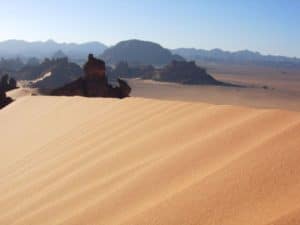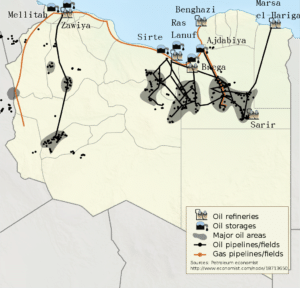Natural hazards come in the form of hot, dry, dust-laden sirocco (known in Libya as the gibli). This is a southern wind blowing from one to four days in spring and autumn. There are also dust storms and sandstorms. Oases can also be found scattered throughout Libya, the most important of which are Ghadames and Kufra. Libya is one of the sunniest and driest countries in the world due to prevailing presence of desert environment.
The Libyan Desert, which covers much of Libya, is one of the most arid and sun-baked places on earth. In places, decades may pass without seeing any rainfall at all, and even in the highlands rainfall seldom happens, once every 5–10 years. At Uweinat, as of 2006 the last recorded rainfall was in September 1998.

Likewise, the temperature in the Libyan Desert can be extreme; on 13 September 1922, the town of ‘Aziziya, which is located southwest of Tripoli, recorded an air temperature of 58 °C (136.4 °F), considered to be a world record. In September 2012, however, the world record figure of 58 °C was overturned by the World Meteorological Organization.
There are a few scattered uninhabited small oases, usually linked to the major depressions, where water can be found by digging to a few feet in depth. In the west there is a widely dispersed group of oases in unconnected shallow depressions, the Kufra group, consisting of Tazerbo, Rebianae and Kufra. Aside from the scarps, the general flatness is only interrupted by a series of plateaus and massifs near the center of the Libyan Desert, around the convergence of the Egyptian-Sudanese-Libyan borders.
Slightly further to the south are the massifs of Arkenu, Uweinat, and Kissu. These granite mountains are ancient, having formed long before the sandstones surrounding them. Arkenu and Western Uweinat are ring complexes very similar to those in the Aïr Mountains. Eastern Uweinat (the highest point in the Libyan Desert) is a raised sandstone plateau adjacent to the granite part further west.

The plain to the north of Uweinat is dotted with eroded volcanic features. With the discovery of oil in the 1950s also came the discovery of a massive aquifer underneath much of Libya. The water in this aquifer pre-dates the last ice ages and the Sahara Desert itself. This area also contains the Arkenu structures, which were once thought to be two impact craters.
Economy:
The Libyan economy depends primarily upon revenues from the oil sector, which account for over half of GDP and 97% of exports. Libya holds the largest proven oil reserves in Africa and is an important contributor to the global supply of light, sweet crude. During 2010, when oil averaged at $80 a barrel, oil production accounted for 54% of GDP. Apart from petroleum, the other natural resources are natural gas and gypsum.

The World Bank defines Libya as an ‘Upper Middle Income Economy’, along with only seven other African countries. Substantial revenues from the energy sector, coupled with a small population, give Libya one of the highest per capita GDPs in Africa. This allowed the Libyan Arab Jamahiriya state to provide an extensive level of social security, particularly in the fields of housing and education.
